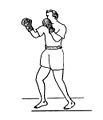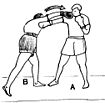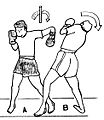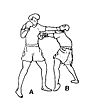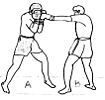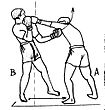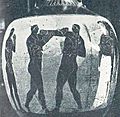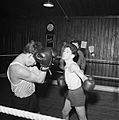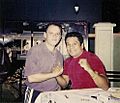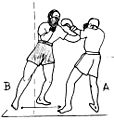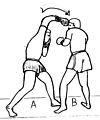Boxing facts for kids
Boxing is an exciting sport where two athletes, called boxers, compete in a special area called a ring. They wear protective gloves and try to hit each other using their fists. It's one of the oldest fighting sports in the world!
There are a few ways to win a boxing match. One way is by a knockout (KO). This happens when a boxer is hit so hard they fall down and can't get back up within ten seconds. Another way is a technical knockout (TKO). This is when a boxer can't continue fighting, or the referee stops the fight to protect them. Boxers can also win by points. This means they hit their opponent more often, harder, and more accurately during the fight. Sometimes, a match can end in a draw, which is like a tie. This can happen if the fight is stopped early due to an accidental injury, or if the judges' scores for both boxers are equal. Boxing is very popular around the world.
Contents
What Gear Do Boxers Use?
Since boxing involves strong punches, boxers need special gear to stay safe.
Hand and Head Protection
- Hand Wraps: These are used to keep the bones in a boxer's hands secure and prevent injuries.
- Boxing Gloves: These protect the hands from hard hits. They also allow boxers to punch with more force than if they didn't wear them. Gloves have been required in fights for a long time. Boxers agree on the weight of the gloves before a match. Lighter gloves can mean harder hits.
- Mouthguard: This is super important! It protects a boxer's teeth and gums from injury. It also helps cushion the jaw, which can lower the chance of a knockout.
Footwear and Training Equipment
- Shoes: Boxers wear soft-soled shoes to prevent injuries from accidental stepping.
- Punching Bags: Boxers use two main types of bags to practice.
- A small, teardrop-shaped speed bag helps them improve their reflexes and quick punches.
- A large, cylinder-shaped heavy bag (filled with sand or water) helps them practice powerful punches and body shots.
- Other Training Gear: Boxers also use regular exercise equipment like weights, rowing machines, jump ropes, and medicine balls. These help them build strength, speed, quickness, and stamina.
The Boxing Ring
Boxing matches usually happen in a boxing ring. This is a raised platform with ropes around it. The word "ring" is often used to talk about boxing in general.
How Do Boxers Fight?
Boxers use different techniques to hit and avoid punches.
Stance: How Boxers Stand
The way a boxer stands is called their stance. Modern boxers usually stand more upright with their arms held higher to protect their face.
In a basic upright stance, a boxer stands with their feet about shoulder-width apart. If they are right-handed (called orthodox), their left foot and fist are in front. Their left fist is held near their face, and their right fist is near their chin. Their chin is tucked down to protect their jaw. Boxers learn this basic stance, but many change it to fit their own style. For example, fast boxers might keep their hands lower, while strong boxers might move slowly towards their opponent.
Left-handed boxers are called southpaws. They use a mirror image of the orthodox stance. This can be tricky for orthodox fighters who aren't used to punches coming from the opposite side.
Punches: The Main Attacks
There are four main types of punches in boxing: the jab, cross, hook, and uppercut. Any punch that isn't a jab is considered a power punch. For a right-handed boxer, their left hand is the lead hand, and their right hand is the rear hand.
- Jab – This is a quick, straight punch thrown with the lead hand. It's often used to measure distance, test an opponent's defense, or set up stronger punches. It's the most important punch because it's fast and leaves the boxer less open to counter-attacks.
- Cross – This is a powerful, straight punch thrown with the rear hand. The boxer rotates their body to add power. It's often used to counter an opponent's jab or to set up a hook. It's also called a "straight" or "right" punch.
- Hook – This is a semi-circular punch thrown with the lead hand to the side of the opponent's head. The boxer rotates their body and pivots their foot to add power. Hooks can also target the lower body.
- Uppercut – This is a vertical, rising punch thrown with the rear hand. The boxer shifts their body and pushes upwards with their knees to deliver this punch. It's often used to lift an opponent's chin, making them vulnerable for another punch, like a hook.
Boxers often throw these punches one after another to create combinations or "combos." The most common is the "one-two combo," which is a jab followed by a cross. The jab can block the opponent's view, making the cross harder to see and avoid.
Some other punches you might hear about include:
- Haymaker or Roundhouse: A large, swinging punch. It can be powerful but often leaves the boxer off balance and open. Trainers usually see it as a sign of poor technique.
- Bolo punch: A rare punch where the boxer swings their arm in a wide arc, often to distract the opponent before hitting them.
- Rabbit punch: An illegal punch to the back of the head or neck.
Defense: How Boxers Avoid Hits
Boxers use several ways to avoid or block punches:
- Slipping: Moving the head to the side to let a punch pass by.
- Bobbing: Moving the head and upper body down and to the side to avoid punches.
- Blocking: Using arms or gloves to stop a punch.
- Cover-Up: Keeping the gloves close to the face and body to protect against hits.
- Clinching: Holding onto the opponent to stop them from punching, usually for a short time.
- Footwork: Moving the feet quickly to get out of the way or to a better position.
- Pulling away: Leaning back or stepping back to avoid a punch.
Famous Boxers
- Muhammad Ali
- Rubin "Hurricane" Carter
- Nonito Donaire
- Oscar de la Hoya
- Jack Dempsey
- George Foreman
- Joe Frazier
- Evander Holyfield
- Lennox Lewis
- Joe Louis
- Rocky Marciano
- Brian Mitchell
- Manny Pacquiao
- Willie Pep
- Sugar Ray Robinson
- Max Schmeling
- Mike Tyson
- Floyd Mayweather, Jr.
Related Pages
Images for kids
-
A painting of Minoan youths boxing from around 1650 BC. This shows some of the earliest boxing gloves.
-
Tom Molineaux (left) fighting Tom Cribb in 1811.
-
An Amateur Boxing Club in Wales, 1963.
-
Robert Helenius (right) fighting Attila Levin (left) in Finland, 2010.
-
Ingemar Johansson knocking out Floyd Patterson in 1959.
-
Roberto Durán (right) won world championships in four different weight categories.
-
Nicola Adams (left) was the first female boxer to win an Olympic gold medal. Here with Mary Kom.
-
A painting by George Bellows showing Firpo sending Dempsey out of the ring.
-
Heavyweight champion Muhammad Ali was known for his "out-fighter" style.
-
Famous "brawler" George Foreman.
-
Henry Armstrong was known for his aggressive, non-stop fighting style.
-
Joe Louis fighting Max Schmeling in 1936.
-
A stamp honoring heavyweight champion Gene Tunney.
-
Ukrainian Wladimir Klitschko, a former heavyweight champion.
See also
 In Spanish: Boxeo para niños
In Spanish: Boxeo para niños



